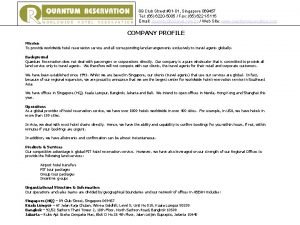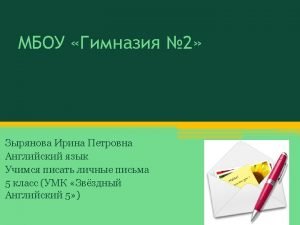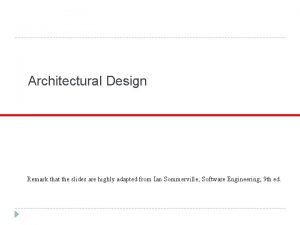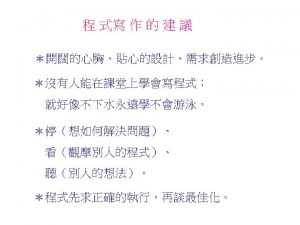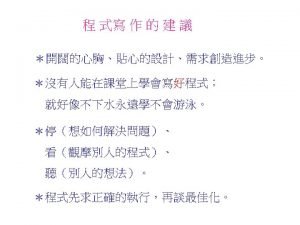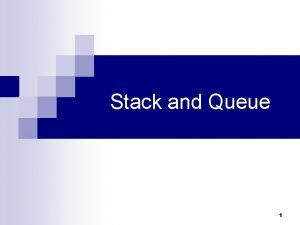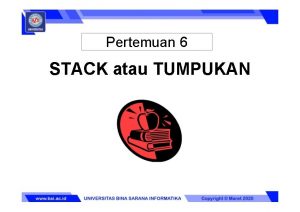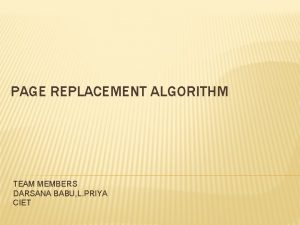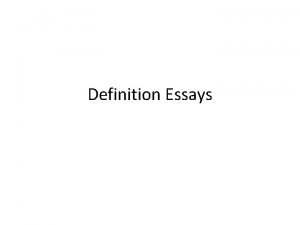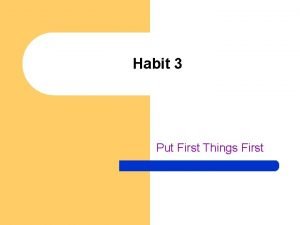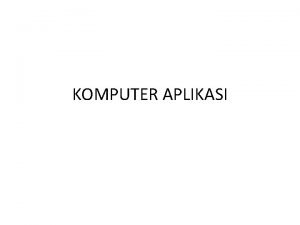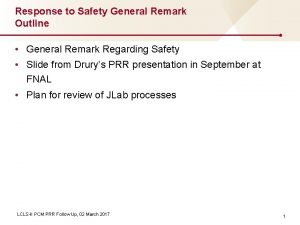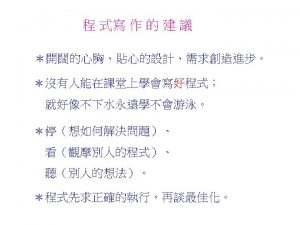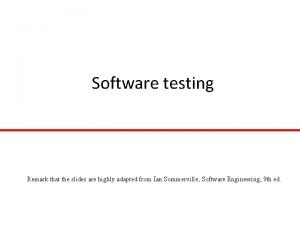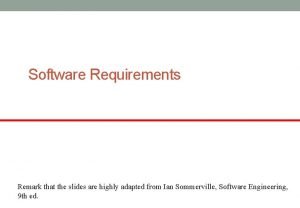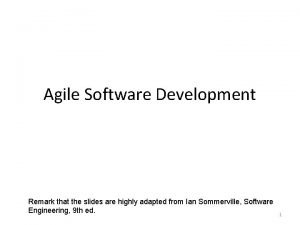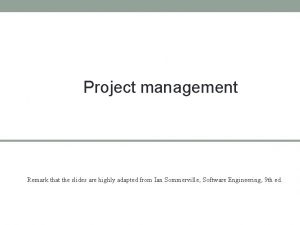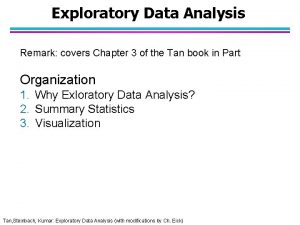First C program remark of C and C











![scanf (“讀取資料的格式” [, &變數名稱] ) int k; scanf(“%d”, &k); float ft; scanf(“%f”, &ft); double scanf (“讀取資料的格式” [, &變數名稱] ) int k; scanf(“%d”, &k); float ft; scanf(“%f”, &ft); double](https://slidetodoc.com/presentation_image/69da2e0c17b7f642059185a0ec8afdd9/image-12.jpg)















![C/C++ 陣列的宣告與使用範例 (1) 陣列的宣告: Data. Type Ex. int array. Name[number_of_element]; ary. Value[10]; float my. C/C++ 陣列的宣告與使用範例 (1) 陣列的宣告: Data. Type Ex. int array. Name[number_of_element]; ary. Value[10]; float my.](https://slidetodoc.com/presentation_image/69da2e0c17b7f642059185a0ec8afdd9/image-28.jpg)




![C/C++ 陣列的宣告與使用範例 (6) Ex. 字元可視為數值或ASCII符號。 int k; char string[10], ch; ch=‘A’; string[9]=‘�’; // or C/C++ 陣列的宣告與使用範例 (6) Ex. 字元可視為數值或ASCII符號。 int k; char string[10], ch; ch=‘A’; string[9]=‘�’; // or](https://slidetodoc.com/presentation_image/69da2e0c17b7f642059185a0ec8afdd9/image-33.jpg)














- Slides: 47


/* First C program , remark of C and C++*/ #include <stdio. h> // for using printf() #define PI 3. 141592653 void main( ) // Program starts from here ! Remark of C++ { printf(“Hello World !n”) ; // ‘n’ : new line } 註解、縮排、include、define、main()、分號、控制碼、 Free-style 、{複合敘述}、void、< >與“ ”的區別


各種資料型態的儲值範圍(各系統可能不同) type modifier data type bytes char 1 range -128 ~ 127 unsigned char int 1 4 0 ~ 255 -2147483648 ~ 2147483647 short long unsigned short unsigned long int int int float double 2 4 4 8 -32768 ~ 32767 -2147483648 ~ 2147483647 0 ~ 4294967295 0 ~ 65535 0 ~ 4294967295 3. 4 E-38 ~ 3. 4 E+38 1. 7 E-308 ~ 1. 7 E+308 *可使用 sizeof ( ) 來求出資料型態在記憶體中的儲存長度(bytes)。





#include "stdio. h" #include "conio. h" printf()的使用 void main() { char ch=128; //注意其值 float f=123. 456; int k=123; printf("testing. . n"); printf("sizeof( 2 )=%d => int defaultn", sizeof(2)); printf("sizeof(1. 0)=%d => double defaultn", sizeof(1. 0)); printf("\x 5 c"�42%%�45x 25n"); printf("1234567890n"); printf("%d %cn", ch); printf("%u %un", ch, (unsigned char) ch);

printf("1234567890n"); printf("%dn", k); printf("%2 dn", k); printf("|%-5 d|n", k); printf("%05 dn", k); printf("%+5 dn", k); printf("%4 Xn", k); printf("1234567890n"); printf("%fn", f); printf("%5. 3 fn", f); printf("|%-8. 2 f|n", f); printf("%08. 3 fn", f); printf("%+8. 3 fn", f); printf("%4. 0 fn", f); }

![scanf 讀取資料的格式 變數名稱 int k scanfd k float ft scanff ft double scanf (“讀取資料的格式” [, &變數名稱] ) int k; scanf(“%d”, &k); float ft; scanf(“%f”, &ft); double](https://slidetodoc.com/presentation_image/69da2e0c17b7f642059185a0ec8afdd9/image-12.jpg)
scanf (“讀取資料的格式” [, &變數名稱] ) int k; scanf(“%d”, &k); float ft; scanf(“%f”, &ft); double d; scanf(“%lf”, &d); char msg[80]; (msg : pointer) scanf(“%s”, &msg); scanf(“%s”, msg); // int hex, oct; scanf(“%d: %d”, &hex, &oct); 可不加& (separated by ‘: ’, it can be other character) int hex, oct; scanf(“%x”, &hex); (hexadecimal) scanf(“%o”, &oct); (octal)







Ex. if statement Ex. if-else statement if ( a>0 ) printf(“a>0n”); printf(“next statement”); else printf(“a<=0n”); printf(“next statement”);




no Ex. a!=0 int a=-1; yes a>0 if ( a!=0 ) if ( a>0 ) printf(“a>0n”); else printf(“a=0n”); no printf(“a=0n”) What is the output ? a=0 敘述next yes printf(“a>0n”)

if- else-if………else 條件 1 yes 敘述 1 no 條件 2 no yes 條件n-1 no yes 敘述 2 敘述n-1 敘述next 敘述n

Transfer score to grade if ( score>=90 ) printf(“Grade A”); else if ( score>=80 ) printf(“Grade B”); else if ( score>=70 ) printf(“Grade C”); else if ( score>=60 ) printf(“Grade D”) else printf(“Grade E”);

if ( score>=90 ) printf(“Grade A”); else if ( score>=80 ) 對應展開上一 頁的if-else的配 對關係 printf(“Grade B”); else if ( score>=70 ) printf(“Grade C”); else if ( score>=60 ) printf(“Grade D”) else printf(“Grade E”);

![CC 陣列的宣告與使用範例 1 陣列的宣告 Data Type Ex int array Namenumberofelement ary Value10 float my C/C++ 陣列的宣告與使用範例 (1) 陣列的宣告: Data. Type Ex. int array. Name[number_of_element]; ary. Value[10]; float my.](https://slidetodoc.com/presentation_image/69da2e0c17b7f642059185a0ec8afdd9/image-28.jpg)
C/C++ 陣列的宣告與使用範例 (1) 陣列的宣告: Data. Type Ex. int array. Name[number_of_element]; ary. Value[10]; float my. Array[30]; 現在我們有了: ary. Value[0], ary. Value[1], ary. Value[2], ary. Value[3], ary. Value[4], ary. Value[5], ary. Value[6], ary. Value[7], ary. Value[8], ary. Value[9]; 1) Zero-based: index starting from zero. 2) To obtain the size of the array, sizeof(ary. Name)/sizeof(ary. Name(0)) => 10


C/C++ 陣列的宣告與使用範例 (3) 隨機產生十個浮點數,並找出最大的數。 Ex. #include <stdlib. h> #define random(n) // for rand (rand() % (n)) // 0 <= random(n) < n, n is an interger. . . int value[10], k, max; value[0] = random(101); max = value[0]; for (k=1; k<10; ++k) { value[k] = random(101); if ( max < value[k] ) max = value; } for (k=0; k<10; ++k) printf(“value[%d]=%dn”, k+1, value[k]); printf(“最大值是:%dn”, max);


![CC 陣列的宣告與使用範例 6 Ex 字元可視為數值或ASCII符號 int k char string10 ch chA string9 or C/C++ 陣列的宣告與使用範例 (6) Ex. 字元可視為數值或ASCII符號。 int k; char string[10], ch; ch=‘A’; string[9]=‘�’; // or](https://slidetodoc.com/presentation_image/69da2e0c17b7f642059185a0ec8afdd9/image-33.jpg)
C/C++ 陣列的宣告與使用範例 (6) Ex. 字元可視為數值或ASCII符號。 int k; char string[10], ch; ch=‘A’; string[9]=‘�’; // or string[9]=0; for (k=0; k<9; ++k) { string[k]=ch++; printf(“%c => %dn”, ch); } printf(“%sn”, string); printf(“%sn”, string+3);


do-while-loop 至少做一次 do { …………. 迴圈內容; }; while ( 條件式 ) ; 敘述next; 條件式 no yes do { job; => } 敘述next while (cond); job; while (cond) { job; } // job; 至少做一次 do { printf(“Input your password: ”); scanf(“%s”, psword); } while ( check(psword) ); 敘述next; 檢查輸入的密碼


Ex. switch-case without break value=‘A’; switch (value) { case ‘A’ : printf(“A”); value=‘A’ ABCnot ABC case ‘B’ : printf(“B”); value=‘B’ BCnot ABC case ‘C’ : printf(“C”); value=‘C’ Cnot ABC default : printf(“not ABC”); value=‘P’ not ABC }; 敘述next;

Ex. switch-case with break value=‘A’; switch (value) { case ‘A’ : printf(“A”); value=‘A’ A case ‘B’ : printf(“B”); value=‘B’ BC case ‘C’ : printf(“C”); value=‘C’ C value=‘P’ not ABC break; default : printf(“not ABC”); }; 敘述next;

break : 跳出迴圈, 至敘述next(迴圈後的下一敘述) continue: 跳至條件變換或條件判斷處 break可用於for-loop, while, do-while, switch continue 則用於for-loop, while, do-while for (k=1; k<10; ++ k) { ………. …. . break; ………. …. . continue; ……. . . }; while ( a>=1 ) { ………. …. . break; ………. …. . continue; ……. . . }; next-statement;

// break case: sum=0; for (n=1; n<=10; ++n) { if ( n==5 ) break; sum+=n; sum=1+2+3+4=10 } // continue case: sum=0; for (n=1; n<=10; ++n) { if ( n==5) continue; sum+=n; } sum=1+2+3+4+6+7+8+9+10=50

位元的介紹 bit (binary digit):位元 => 0 or 1 byte = 8 bits:位元組 word = 2 bytes = 16 bits:字組 位 元 的 稱 呼 (與冪次有關) 1 0 1 0 1 27 26 25 24 23 22 21 20 bit 7 bit 6 bit 5 bit 4 bit 3 bit 2 bit 1 bit 0




位元的運算例子 (2/2) 若 A = 0 x. D 3 = (1101 0011)2 c) 將 high nibble反相 1 1 0 0 1 1 利用^ (xor)運算 A = A ^ 0 x. F 0; 1 1 0 0 d) 保留 low nibble : 1 1 0 0 1 1 利用& (and)運算 A = A & 0 x 0 F; 0 0 1 1


 The remark of the greek epigrammatist
The remark of the greek epigrammatist Summarize brian’s problem at the end of this chapter.
Summarize brian’s problem at the end of this chapter. Erich maria remargue
Erich maria remargue Remark gatekunst
Remark gatekunst When we remark with surprise that someone
When we remark with surprise that someone Gravic remark test grading edition
Gravic remark test grading edition Closing paragraph informal email
Closing paragraph informal email Sample of remarks
Sample of remarks Remark slides
Remark slides Remark training
Remark training Risk taker
Risk taker Remark 1
Remark 1 Remark 1
Remark 1 Entity framework 7 release date
Entity framework 7 release date State space graph
State space graph Differences between sequential and event-driven programming
Differences between sequential and event-driven programming The maturity continuum covey
The maturity continuum covey Sdl first vs code first
Sdl first vs code first Habit 3 lesson plans
Habit 3 lesson plans Put first things first meaning
Put first things first meaning First to file vs first to invent
First to file vs first to invent Data structure stack
Data structure stack Prinsip stack
Prinsip stack First in first out
First in first out First come first serve
First come first serve Put first things first definition
Put first things first definition Fcfs calculator
Fcfs calculator See-do-get model example
See-do-get model example Habit number 3
Habit number 3 Put first things first video
Put first things first video Habit 3 activities
Habit 3 activities First aid merit badge first aid kit
First aid merit badge first aid kit Which is an objective of first aid
Which is an objective of first aid Put first things first
Put first things first Riverside county home buyers
Riverside county home buyers Basic physical activity
Basic physical activity First action interview pilot program
First action interview pilot program Perangkat lunak komputer disebut .... *
Perangkat lunak komputer disebut .... * Merancang program tahunan dan program semester
Merancang program tahunan dan program semester Microsoft+excel+merupakan+program+aplikasi
Microsoft+excel+merupakan+program+aplikasi Orientasi program ms excel adalah pada pengolahan
Orientasi program ms excel adalah pada pengolahan Memulai microsoft word
Memulai microsoft word Newton's first law and second law and third law
Newton's first law and second law and third law Newton's first law and second law and third law
Newton's first law and second law and third law First person and second person and third person
First person and second person and third person Neurological considerations in language acquisition
Neurological considerations in language acquisition Sdlc principles and practices
Sdlc principles and practices Security program and policies principles and practices
Security program and policies principles and practices



